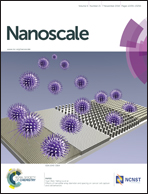A novel upconversion, fluorescence resonance energy transfer biosensor (FRET) for sensitive detection of lead ions in human serum†
Abstract
There has been great progress in the development of fluorescence biosensors based on quantum dots (QDs) for the detection of lead ions. However, most methods are detecting lead ions in aqueous solution rather than in human serum due to the influence of protein autofluorescence in serum excited by visible light. Thus, we developed a novel fluorescence resonance energy transfer (FRET) biosensor by choosing the upconversion NaYF4:Yb3+/Tm3+ nanoparticles as the energy donor and the CdTe QDs as the energy acceptor for lead ion detection. It is the first near infrared (NIR)-excited fluorescent probe for determination of lead ions in serum that is capable of overcoming self-luminescence from serum excitation with visible light. The sensor also shows high selectivity, a low detection limit (80 nm) and good linear Stern–Volmer characteristics (R = 0.996), both in the buffer and serum. This biosensor has great potential for versatile applications in lead ion detection in biological and analytical fields.


 Please wait while we load your content...
Please wait while we load your content...